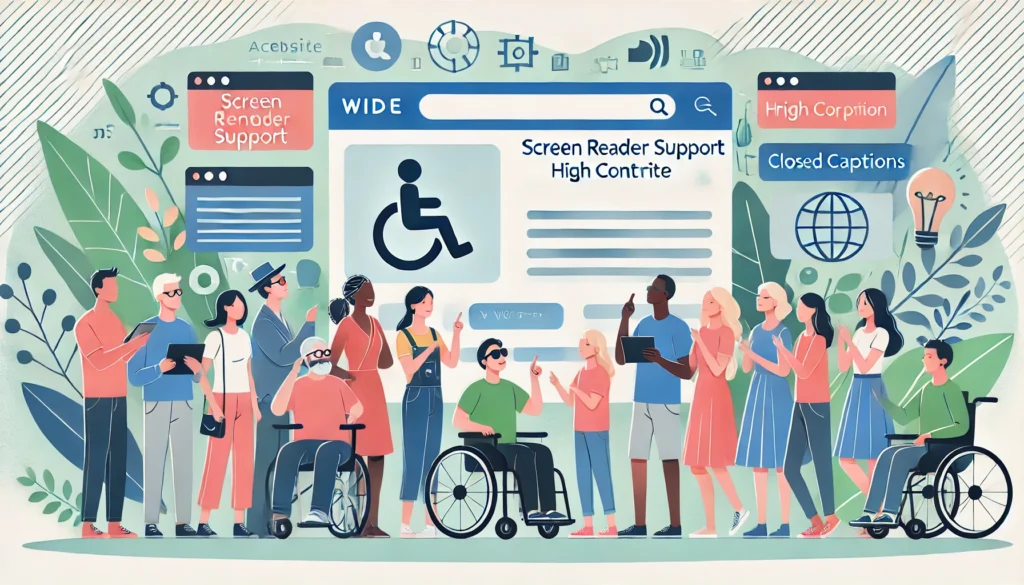
Web Accessibility: Making Websites Inclusive for Everyone
In today’s digital age, the internet has become a crucial part of our daily lives, whether we’re working, learning, shopping, or socializing. But for millions of users with disabilities, accessing websites can be challenging if accessibility isn’t taken into account. Web accessibility ensures that everyone, regardless of their abilities or disabilities, can interact with and benefit from what websites have to offer. This guide will walk you through the importance of accessibility, legal and ethical considerations, and practical steps for making your website inclusive.
Why Web Accessibility Matters
1. Inclusivity and Equal Access
Approximately 15% of the world’s population experiences some form of disability, according to the World Health Organization. Disabilities can affect vision, hearing, mobility, cognition, and more. Making websites accessible ensures that all individuals, regardless of their abilities, can navigate, understand, and interact with online content.
2. Legal Compliance
Many countries have laws requiring websites to be accessible. In the U.S., for instance, the Americans with Disabilities Act (ADA) mandates digital accessibility for certain websites, while the European Union enforces accessibility standards through the Web Accessibility Directive. Non-compliance with these laws can lead to legal consequences.
3. Broader Audience and SEO Benefits
Accessible websites reach a wider audience, including people with disabilities, older users, and those with temporary impairments. Additionally, accessible websites are often better optimized for search engines, since accessibility features like alt text, captions, and semantic HTML benefit SEO by making content easier for search engines to interpret.
Core Principles of Web Accessibility
Web Content Accessibility Guidelines (WCAG) provide a solid framework for accessibility standards. WCAG defines four principles that websites should follow:
- Perceivable – Information and UI components must be presented in ways that all users can perceive. For example, providing text alternatives for images enables screen readers to interpret visuals for visually impaired users.
- Operable – Website navigation and functionality should be usable by people with various disabilities. This includes allowing keyboard-only navigation and ensuring no time-based limitations for input.
- Understandable – Content and functionality should be easy to understand. This principle encourages clear language, consistent navigation, and error-correcting mechanisms.
- Robust – Websites should be compatible with various assistive technologies, ensuring that future updates don’t break accessibility.
Key Web Accessibility Practices
Here are some effective ways to make your website more accessible, following the principles mentioned above:
1. Use Semantic HTML
Semantic HTML (e.g., <header>, <footer>, <nav>) enhances accessibility by providing a structure that assistive technologies can interpret accurately. Screen readers, for example, can better understand content if it’s organized with semantic tags, making it easier for users to navigate and comprehend.
2. Provide Alt Text for Images
Descriptive alt text enables screen readers to convey the meaning of images to visually impaired users. Aim to provide context rather than describing every visual detail, e.g., “A person typing on a laptop” rather than “A photo showing a person’s hands typing on a keyboard.”
3. Ensure Color Contrast and Avoid Reliance on Color Alone
Many users have color vision deficiencies or low vision. To make your content accessible, ensure sufficient contrast between text and background colors. WCAG recommends a contrast ratio of at least 4.5:1 for normal text. Additionally, avoid using color alone to convey important information; use symbols or text labels to reinforce meaning.
4. Make Navigation Keyboard-Friendly
Not everyone uses a mouse. Some users rely solely on keyboards or assistive devices for navigation. Ensure that users can access all interactive elements—like buttons, forms, and menus—through keyboard input. This can be tested by navigating your website using only the Tab, Enter, and Arrow keys.
5. Include Captions and Transcripts for Multimedia
Videos and audio content should have captions and transcripts available for users with hearing impairments. Captions are essential for conveying spoken words and sound effects, while transcripts provide a full text version of audio content that’s accessible to screen readers.
6. Use ARIA (Accessible Rich Internet Applications) Attributes
ARIA attributes can enhance accessibility, especially for dynamic content. For example, aria-live can notify screen readers when content updates on the page, and aria-label provides descriptive labels for interactive elements. Be cautious with ARIA attributes, as improper use can lead to confusion for assistive technology users.
7. Design for Easy Readability
Make content easy to read by using clear, simple language and dividing text into short paragraphs with headers. Users with cognitive disabilities may find large blocks of text overwhelming, so breaking up content and using visual hierarchy improves readability for all.
Tools for Testing Accessibility
There are several tools to help you test and improve your website’s accessibility:
- WAVE: The Web Accessibility Evaluation Tool offers a visual summary of accessibility issues on a page, highlighting areas for improvement.
- Lighthouse: A Chrome DevTools feature that provides accessibility audits and scores, offering specific suggestions for improvement.
- axe Accessibility Checker: An extension by Deque that identifies and explains accessibility issues, with guidance on how to resolve them.
- Color Contrast Checker: Use tools like WebAIM’s Contrast Checker to verify that your color choices meet WCAG contrast requirements.
Accessibility as an Ongoing Process
Creating an accessible website isn’t a one-time effort; it’s an ongoing commitment. Accessibility standards and user needs evolve, so regularly testing and updating your site is crucial. Feedback from users with disabilities can be invaluable in identifying new areas for improvement and ensuring that your website meets the highest accessibility standards.
Conclusion
Making your website accessible benefits everyone: it creates an inclusive online space, improves user satisfaction, and even boosts SEO. By implementing accessibility best practices, you’re contributing to a more inclusive internet where everyone, regardless of ability, can access the resources and services they need.
Web accessibility is not just a trend; it’s a commitment to equity and inclusivity. Let’s work together to make the web a welcoming place for everyone!
